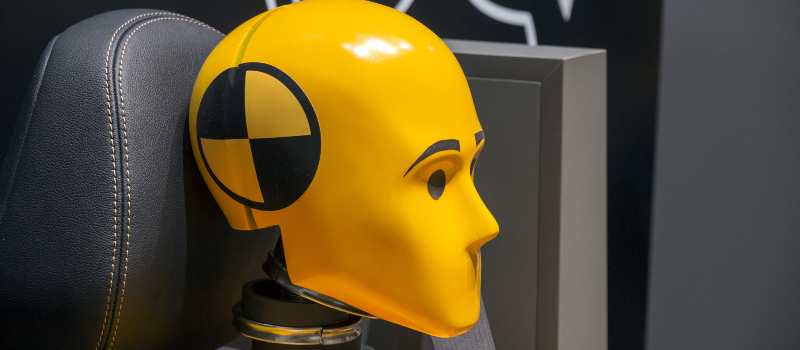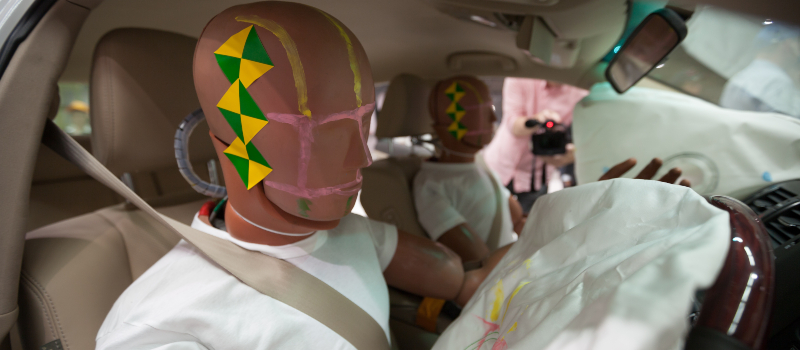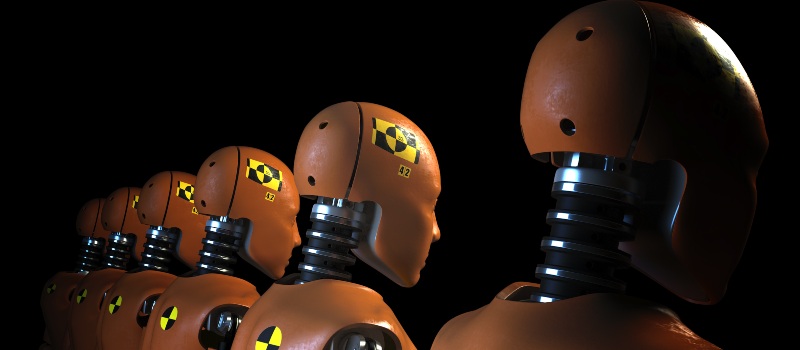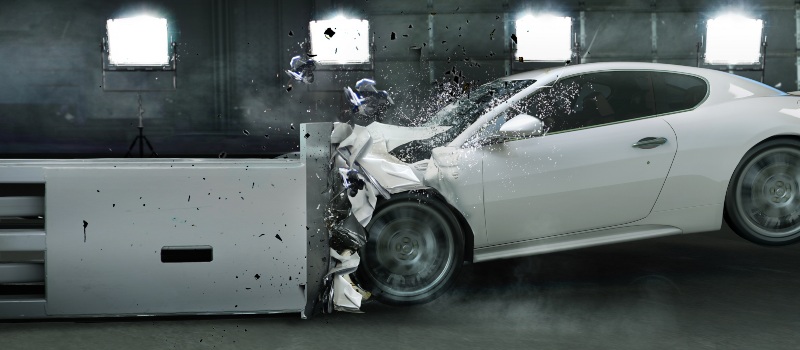
What’s life like for a crash test dummy?
29th Jun, 2020
With our opposable thumbs and highly developed brains, humans have evolved for many things. Safe to say, car crashes have never been one of them. Modern automobiles are actually terrifying machines when you think about it, allowing us to hurtle down a highway at speeds we were never naturally meant to achieve.
So how do we all stay so impressively sanguine about the dangers? Well, that’s mainly because we know they’ve been mitigated by all the highly-developed safety mechanisms built into modern cars – ones that wouldn’t have been possible without crash test dummies. Mostly artificial, but yes, one or two brave humans too. Without crash test dummies, it’s likely far fewer of us would be around to realise ‘I need to scrap my car’ after a collision. So this week we thought we’d take a moment to salute these guys, and the immeasurable contributions they’ve made to our safety.
How do we learn from crash test dummies?
Crash test dummies are essentially human-shaped mannequins, but far more detailed and sophisticated than the type you’d see modelling shirts or scarves in shop windows on the high street. Within the automotive industry they’re referred to by the even-catchier moniker of ADTs, or anthropomorphic test devices. Anthropomorphic, as you probably know, means ‘having human-like qualities or characteristics’, and that is massively important for crash test dummies.
We won’t get too deeply into a physics lesson here, but basically the average car crash involves significant changes in kinetic energy, and the primary purpose of an ADT is to provide accurate data on how that energy can affect the human body in a real-world scenario. Examples of the sorts of raw data engineers collect using ADTs include information on the velocity of an impact, the crushing force involved, and any bending, folding or torque of the body. (All sounds pretty unpleasant, doesn’t it?)
In order to reliably provide all this raw data, ADTs have to mimic human bodies as closely as possible. That’s why even relatively basic models have a high level of detailed anatomical accuracy, from the proportions of their body parts, all the way down to their elbows, knees and other joints.
All of these have to move and react in realistic ways to simulate the types and scale of injuries that could occur in an accident, helping engineers to design safeguards against them. Airbags and seatbelts are just a couple of the modern life-saving innovations that wouldn’t been fully possible without the use of crash test dummies. (To give you an idea of the kind of detail involved, modern Hybrid III crash test dummies have metal spines, moveable necks, steel ribcages, vinyl skin and realistic knees.)
Different parts of the crash test dummy are painted with different colours, essentially so that engineers can work out which squishy body parts are currently smashing into which unyielding surfaces. The crash test dummies themselves are now built in a variety of sizes and shapes, to account for as many different body types as possible.

A brief history of the crash test dummy
We’ll be honest – the origins of the crash test dummy are a little dark. We’ll cast your mind back to the halcyon days of the early 1930s, an era where cars were already widespread, but weren’t nearly as safe as they were today. (Seatbelts didn’t become mandatory until 1968, for example.) One team set out to change that; an American group of researchers at Wayne State University began to run safety tests with cars using cadavers, which is a slightly nicer word people sometimes use to describe corpses.
Now, there’s no question that if you’re looking for something that reacts to the punishing effects of physics with all the realism of a human body, then we guess you can’t go wrong with an actual human body. Where did they get them, you ask? Well, some were volunteers, who donated their bodies to science in the event of the deaths. But there are some lingering suspicions that not all of these bodies were acquired through the proper channels, if you catch our drift. History mostly tends to gloss over that bit. We think we will too.
Anyway, not every group of researchers apparently had access to a worryingly limitless supply of bodies, so they began turning to men like United States Air Force Colonel John Stapp. In the 1950s he became famous as a volunteer for NASA’s Rocket Sled, which was exactly what it sounds like. Wayne State University also had its very own human volunteer on hand – resident professor Lawrence Patrick, a man whose boundless zest for science was apparently only equalled by his disregard for his own safety, since he volunteered himself more than four hundred times. (Human test dummies, both living and dead, are still used today. Thankfully, far more rarely.)
In time, the industry decided that it should probably look for alternatives to using actual human bodies, however alive or dead they happened to be at the time. And so, the first artificial crash test dummy came to be. He was called Sierra Sam, and first constructed in 1949 to test aircraft ejection seats. (Maybe they couldn’t even get Col. Stapp to do that one.)
Sierra Sam also remains one of the very few crash test dummies to be given an actual name. He was what’s called a 95th percentile male dummy – which means he’s heavier and taller than 95% of human males. Safety systems always work best when they’re slightly overdesigned.
A few years after Sierra Sam was produced, Ford created their own versions in the mid-1950s, slightly less affectionately dubbed FERD1 and FERD II. They had electronic instruments for brains, steel skeletons with plastic parts to emulate muscle, all coated with softer plastic to simulate skin.
Less than 20 years after that, General Motors created the world’s first standardised automotive crash test dummy, named the Hybrid I. Following another iteration, 1978 saw the production of the Hybrid III crash test dummy, which is now one of the most widely-used crash test dummies on the face of the globe. We’ve already touched on all the modern enhancements that the modern version boasts, including sophisticated sensors and advanced materials to indicate where an impact might induce soft tissue damage, broken bones or even life-threatening internal injuries.

A day in the life of a crash test dummy
Over sixty years on from the design of their first FERD1 model, Ford’s crash test lab in Merkenich, Germany now has its own host of Hybrid IIIs amongst its store of crash test dummies, which run the full gamut from tiny child-sized models to bodies that weigh over 100kg. The Hybrid IIIs are primarily used for frontal impact tests, and none have their own individual name like Sierra Sam, but are identified by numbers instead. Here’s what the average one’s schedule is like.
Morning
It’s an early start for our hero – a 7am start, in fact, so he can empathise with those of us with 9 to 5s. Of course, he doesn’t exactly have a huge commute to contend with, but getting him in the test vehicle is more than a case of just plonking him down in the seat. It can take anywhere from a few hours to half a day to install him in the seat, ready for testing, and correctly calibrate his sensors. Some Hybrid IIIs have as many as 200 of them.
Midday
In the final minutes leading up to the test, all his sensors and restraints (or lack thereof) are checked a final time, to make sure everything is definitely aligned and calibrated as it should be. All the mechanisms present in the test vehicle are subject to one last examination, too. It’s normally at this point that the dummy braces itself.
One minute past midday
At the sound of an alarm, our intrepid friend and his vehicle are abruptly launched towards a deformable metal barrier at speeds of about 64 km/h. Powerful lights and high speed video cameras are fixed on the barrier, and within just a few milliseconds of the impact, the airbags and seatbelt pre-tensioners deploy. The high speed cameras capture every tiny detail as the crash test dummy experiences what Ford rather clinically describes as ‘extreme deceleration’, and no doubt gains new empathy for any fly that’s ever suddenly encountered a windscreen.

Ten minutes past 12
Less than ten minutes after the impact, Ford’s technicians will descend on what’s left of the car to remove the instrumentation from the dummy, and extract him from the wreckage. The vehicle itself is then gathered up and despatched to the crusher for recycling, in much the same way that we recycle cars right here at Scrap Car Network.
3pm
Now the crash test dummy undergoes a more extensive evaluation, as the technicians work to establish exactly how significantly he was damaged. As soon as all the relevant notes have been taken and all the tests have been carried out, he’s returned to his holding area. If he’s one of the Hybrid III models with a hook in the top of his head, he’ll be stored standing. If not, he gets to sit down until he’s called for his next test, in the most high-octane waiting room imaginable.
5pm
Our lucky man gets to do this (on average) nine more times before he’ll be sent to a specialised crash test dummy facility for repair and recalibration. They’ll take around two days to give him a full health report, and repair him if necessary. To be honest, even the recalibration tests are a little rough – they involve things like swinging metal objects into the dummies’ heads and knees and chests. In case you’re interested, the most common injury amongst dummies is broken ribs – which is indeed also one of the most common injuries sustained by real humans in car accidents.
An alternate vision of life without crash test dummies
When it comes right down to it, the main reason why we need crash test dummies is that humans simply aren’t built to survive car crashes. We’re not evolved that way. But one particularly effective road safety campaign in Australia has given us quite an unnerving vision of what we might look like if we were. His name is Graham, and he’s the creation of Patricia Piccinini – a sculptor, trauma surgeon and road safety engineer. He, erm… he leaves quite the impression.
As you’ll see, Graham doesn’t look at all like a member of our human race. His body doesn’t always work like ours either. He’s been designed to give us an idea of all the natural abilities and evolutionary traits we’d need to have a hundred percent survival rate in car accidents, and underlines pretty well how poorly-equipped we are for high-speed crashes. His many notable traits include:
- Tougher, thicker skin to protect him against abrasions and road rash
- A ‘helmet-like’ skull, bigger and thicker than ours, and containing more fluid and ligaments, so his brain can afford to bounce around a bit more in the event of a crash
- A flat face with in-built crumple zones, and far more fatty tissue to absorb the energy of an impact
- A neck that’s reinforced by a bony brace-like structure
- Multiple sacks to protect his ribs, acting like a natural set of airbags to cushion an impact
- Knees which move in all directions – which is freaky, but makes them less likely to be injured if he’s hit as a pedestrian
- Hoof-like legs with digitigrade feet, and added joints that enable him to leap out of the way in a ‘spring-loaded’ fashion
It’s highly unlikely you have those sorts of evolutionary advantages to rely upon in the event of a crash, so heed the advice an experienced human crash test dummy, the eminent Mr Rusty Haight. His wisdom can be summed up in three simple words: wear your seatbelt. And most importantly, wear it properly. That means low on your hips and properly behind your chest. Don’t let it out of position, and don’t put your feet up on the dashboard. Now, you’ll note that putting your feet up on the dashboard as something pretty difficult to do absent-mindedly, so honestly – just let the seatbelt do its job, and drive sensibly!
In fact, driving sensibly is one of the most important bits too. Not only does it ensure your safety and that of your passengers, but it also means that your car is far more likely to peacefully reach the end of its useful lifespan, and you can avoid having to scrap your car after a particularly devastating collision. However your car meets its end though, you can always count on us here at Scrap Car Network to be able to help. We’ve made sure it’s never been easier to scrap your car with us – all you have to do is enter in your car reg and postcode onto the fields in our homepage, and you’ll have your very own instant scrap car quote. It’s all go from there!